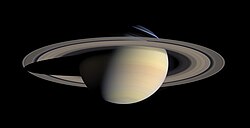Hor-ka-pet
| Hor-ka-pet in Hieroglyphen | |||||||
|---|---|---|---|---|---|---|---|
| Neues Reich | |||||||
| Gr.-röm. Zeit | Hor-ka-pet Ḥr-k3-pt Horus, der Himmelsstier | ||||||
| Der Planet Saturn als Himmelsstier | |||||||
Hor-ka-pet ist ein weiterer altägyptischer Name der Gottheit Horus. In der altägyptischen Mythologie und altägyptischen Astronomie bezeichnete Hor-ka-pet als Himmelsstier den Planeten Saturn.
Hintergrund
Im Planetenkapitel des Nutbuches wird in den Zeilen 153 bis 159 über einen kosmischen Streit zwischen Horus und Seth bei Sonnenuntergang berichtet, der schließlich durch die Vermittlung von Thot beigelegt werden kann.[1]
Die weiteren himmlischen „Gefolgsleute des Seth“ sind wie auch Seth im westlichen Himmel verortet. Da sich Horus gleichfalls im Westen befindet und der Planet Saturn auch Stern des Westens genannt wurde, konnte er der Gottheit Horus zugeordnet werden.
Siehe auch
Literatur
- Christian Leitz u. a.: LGG, Bd. 5. Peeters, Leuven 2002, ISBN 90-429-1150-6, S. 293.
- Alexandra von Lieven: Grundriss des Laufes der Sterne – Das sogenannte Nutbuch. The Carsten Niebuhr Institute of Ancient Eastern Studies (u. a.), Kopenhagen 2007, ISBN 978-87-635-0406-5.
Einzelnachweise
- ↑ Alexandra von Lieven: Grundriss des Laufes der Sterne. S. 199–200.
Auf dieser Seite verwendete Medien
While cruising around Saturn in early October 2004, Cassini captured a series of images that have been composed into the largest, most detailed, global natural color view of Saturn and its rings ever made.
This grand mosaic consists of 126 images acquired in a tile-like fashion, covering one end of Saturn's rings to the other and the entire planet in between. The images were taken over the course of two hours on Oct. 6, 2004, while Cassini was approximately 6.3 million kilometers (3.9 million miles) from Saturn. Since the view seen by Cassini during this time changed very little, no re-projection or alteration of any of the images was necessary.
Three images (red, green and blue) were taken of each of 42 locations, or "footprints," across the planet. The full color footprints were put together to produce a mosaic that is 8,888 pixels across and 4,544 pixels tall.
The smallest features seen here are 38 kilometers (24 miles) across. Many of Saturn's splendid features noted previously in single frames taken by Cassini are visible in this one detailed, all-encompassing view: subtle color variations across the rings, the thread-like F ring, ring shadows cast against the blue northern hemisphere, the planet's shadow making its way across the rings to the left, and blue-grey storms in Saturn's southern hemisphere to the right. Tiny Mimas and even smaller Janus are both faintly visible at the lower left.
The Sun-Saturn-Cassini, or phase, angle at the time was 72 degrees; hence, the partial illumination of Saturn in this portrait. Later in the mission, when the spacecraft's trajectory takes it far from Saturn and also into the direction of the Sun, Cassini will be able to look back and view Saturn and its rings in a more fully-illuminated geometry.
